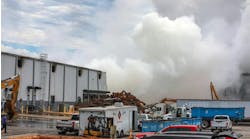Transcript:
Traci: Welcome to this edition of "Process Safety with Trish & Traci," the podcast that aims to share insights from past incidents to help avoid future events. I'm Traci Purdum, Executive Digital Editor with Chemical Processing. And as always, I'm joined by Trish Kerin, the Director of the IChemE Safety Centre. Hey, Trish, how are you?
Trish: I'm good, Traci. How are you doing?
Traci: I'm doing well. What's new with you this week?
Trish: Oh look, it's just a really busy time of the year for me. There's a lot of conferences and events happening at this time of the year, so I do find I'm doing a lot of different speaking events over the next few months. So that's always something to look forward to because I actually do enjoy connecting with people, and talking about process safety as you know.
Traci: Well, I do know, and I know that you're the expert, and everybody wants a piece of you, so I feel fortunate that you are my partner on this podcast. So thank you very much for that.
Trish: My pleasure.
Traci: In today's episode, we're going to focus on subtleties. And hazard and operability studies are a common process hazard analysis technique designed to find the big safety offenders. However, to really ensure process safety, facilities must also focus on subtle changes, which can lead to degradation of the design safeguards. Enter Delta HAZOP. Trish, can you tell us what Delta HAZOP is?
No worries! Subscribe and listen whenever, wherever.
Trish: Sure. Well, unfortunately, Delta HAZOP probably doesn't have the best of names anymore, now that we've got the Delta variant of COVID. But we had the name first, so that's what it is. Delta HAZOP, it's an alternative approach to a standard HAZOP type activity. So it's something a little different. It really focuses you more on the subtle changes that can accumulate over time, and create this creeping of the system and the standards, and how things operate.
In the past, we used to talk a lot about something called a redo HAZOP, and that comes out of the CCPS revalidation process and methods guidance, which is a fantastic guidance on how to do that revalidation. In addition to that, there's an IEC guidance on how to do a HAZOP as well. And it's been around for a very long time, and it's an important tool in our toolkit, the standard HAZOP. Delta HAZOP is a different way to look at it. We actually go about doing things a bit differently in the Delta HAZOP. Your standard HAZOP is guide-word approached, and it prompts you to look through scenarios, and you view the node with the guide-word checklist.
Delta HAZOP focuses on the evidence and the data for what has changed. It’s not using a standard guide-word checklist at all. It does use a checklist to prompt you to think about and explore things. But it's looking about what has changed, and it tends to view the system more holistically in itself, rather than focusing only on the specific node at a time. You still do look at the node, but you look at it more broadly how that node interacts as well. So it's a little bit different in that way, too.
The webinar on YouTube -- https://youtu.be/UnAvwACocyg
IChemE Safety Centre Delta HAZOP guidance documents:
https://www.icheme.org/media/17097/effective-revalidation-of-risk-assessments-delta-hazop.pdf
Enquiries regarding the Delta HAZOP leader training can be directed to [email protected]
And Delta HAZOP has been around for a little while. There have been many companies that have been doing a version...their own version of Delta HAZOP, and in fact, we wrote this guidance document because ExxonMobil have been doing this...doing a version of Delta HAZOP for quite some time. They did a bit of conference paper on it, and then they came to us and said, we've had a lot of interest in this. Can we work together on maybe producing a guidance document? And so we did work with them, and a number of other companies around the world, to pick out all the best things of what people have been doing in this way to analyze risk and produce a comprehensive guidance document on it.
Traci: You talk about the subtleties of changes over time, and looking toward those. That requires facilities to keep a good record of those changes, right?
Trish: Yes, it does. However, you need to understand not only your management of change, which is critical in this process, you've got to have a solid management of change process in your facility for a range of good process safety and reliability reasons. But Delta HAZOP also asks you to look a little bit deeper because not everything is covered in the management of change. And, you know, that's not a critique of anybody's system. But the fact is, is that some things will be missed, some things will be assumed to be like for like when they actually weren't. But also sometimes things just wear out, and there's no physical change that's been implemented, but change has occurred. It's crept in. So things like, you know, bearings will start to wear in rotating equipment. And that may change how that equipment actually performs. It might start moving to a different part of its performance curve because those bearings start to wear over time.
Now there's not necessarily a management of change on wear and tear, obviously. Changes do occur, even when we don't actively implement changes in a facility. The idea of doing the Delta HAZOP... You wouldn't normally consider management of change activities and changes not in MOC processes as deeply within a standard HAZOP as well. We're looking at different information here. We need additional information. We need to understand what some of those cumulative change impacts are. So if your pump is operating in a different part of the curve, just because pumps fail and age, and those sorts of impacts, what is that doing to the pressure in your system? Is it affecting the flow rate in your system? Is that affecting how efficient your system is in doing something else? All these things are interconnected. And that's not necessarily something HAZOP looks at.
You'd also want to consider things like any staffing changes that have occurred. Often they're not done through MOC either sadly, and so the changes...the impact of the changes are not necessarily picked up. Have there been regulatory changes that have impacted on you, and how you need to do things, or have your company's standards changed? What have some of your risk assessment...other risk assessment reports noted or uncovered? And what are your inspection and audit reports telling you? What are your incident reports telling you? What are they uncovering that there might be something happening that wasn't necessarily done in a management of change process, but is nevertheless a creeping and cumulative change in your facility?
Traci: Who is in charge of that? Various operators have that information at the ready, and they can see what's happening. But is there one person in charge of putting it all together, getting all the clues, and putting it all together?
Trish: Well, ultimately, like a HAZOP, you still have to have a study leader, and that study leader is accountable for ensuring the study operates as it is meant to, to deliver the outcomes that you're looking for. So that person is accountable to make sure that all the information is collected, and then reviewed and analyzed by the team. So this is still a team workshop activity. The interesting thing is, experience says that this team workshop activity doesn't take as long as a traditional HAZOP either. So the fact is we might be able to get some better risk management results or less time invested by the team. Now, you've got to make sure that Delta HAZOP is the right process for you to do that because it needs to...and I want to be very clear, this is not a cost-cutting, short-cutting exercise. This is actually about uncovering true risk of high value that's going to help your facility.
It does happen to take, by the experience, a little bit less time in the workshops. It does take a little bit more time to prepare for that, because you have to find more information, and your study leader, in conjunction with others in the facility, you know, the technical people in certain areas, have to analyze and pull together what some of that material means before the actual workshop. Though the workshop might take you about half the time, the fact is there is a little bit more preparation time to it as well.
Traci: Well, obviously, Delta HAZOP isn't the starting point. And you've gone over some of them. But can you explain the prerequisites before you even start the Delta HAZOP?
Trish: Yeah, so we've actually put a table in the document, in our guidance document that we've written, for you to consider whether it is the right methodology for you. Is it a suitable thing that you want to do? And there's a certain number of prerequisites you need to understand for that. Now, there's no right or wrong answers to these questions either. That's the challenge. This is not a straightforward thing. We need to make sure we choose the right risk methodologies for the right applications. Some of the questions to consider is you need to go back and look at what information you've got to feed into it.
So we, basically, say that you should have had at least one utilization HAZOP performed on the facility. So Delta HAZOP is not...it doesn't replace your initial design HAZOP, which is also often called...oh, it's just escaped me what that one is called, development HAZOP I think in the IEC standard. And it doesn't replace your first utilization HAZOP because we do a HAZOP on the design. But then when the plant is operating, we do another HAZOP. You know, five years after it starts up, things have changed. We actually didn't perhaps build what we thought we built. So the facility is different. The facility itself has changed, and we need to HAZOP the operating plant. And you still do your first utilization.
And then we go through a series of other questions to say, you need to now consider the answers to these questions, and then make an engineering judgment view on whether you think this is the right process for you. So things like, have all the significant concerns from previous HAZOPs been resolved? All the significant recommendations and findings, have they all been resolved? Was the prior HAZOP team adequate? Did they actually appear to be fully competent in what they were doing? Were there any higher-risk findings in the previous HAZOP that have not been addressed, and...or that even have been addressed? And what were they? How do they impact what's going on? Have there been any significant changes since the last HAZOP? If you've undertaken a significant management of change activity in the facility, then can you actually consider that you've got a clean utilization HAZOP to look at if the facility has changed that much really?
The process safety information, what has changed since the last HAZOP there? How effective and healthy is your MOC process? Do you have a lot of confidence in it that it's actually picking up all the big things? Has there been any significant process safety incidents or near-misses that have occurred since the last HAZOP? And what were they? How do they impact what's going on? Has there been any regulatory governance or company policy, or company ownership change since the last HAZOP? Because all of those things can lead to a change in your risk tolerance at a facility, and may even lead to a change in your standard methodologies used. So how does it fit in with that? Have you modified your risk assessment methodology since the last HAZOP? Is it changing, I mean?
And then another important point is this is a different technique. You actually need to determine whether it meets your local regulatory requirements. If your local authority is not going to accept the outcome of it, and if it's something you need to submit to them, then I'd suggest you probably don't want to do it because that would be a waste of time. You'd need to do something else to meet the regulatory requirements, too. And you don't want to be duplicating work. So, as I said, there's no you answer yes to all these questions, or you answer no to all these questions, and it gives you the result. It's an engineering judgment decision that you need to make at that point in time.
Traci: You mentioned the regulations. That was going to be my next question, what about regulations? But I guess the next natural question is, how often should you perform a Delta HAZOP? Can you do it too often or not?
Trish: I think you can do risk assessment too often where you're not going to be getting the value of insight from the effort you put into it. You can also, obviously, do it too infrequent, and therefore you're not adequately addressing and understanding what your risk levels are because the risk levels do change. As I said, this cumulative and creeping change that occurs really does change your risk profile that you see. And typically we say HAZOP should be done every five years. Well, typically Delta HAZOPs probably should also be done every five years. That seems to be the general accepted frequency of doing risk assessments unless there's a major change to assess. And if you've got a major change to assess, then I suggest you probably go back to your HAZOP because HAZOP is designed to be very systematic, and go through its guide-words to deliver a very detailed review.
What company experience is, in the Delta HAZOP, is over the years, as you keep redoing a HAZOP on a facility that hasn't had...you know, substantially been rebuilt or anything like that, you start to get diminishing returns in terms of the risks that you uncover. And you kind of go, well, that sort of makes sense if I'm applying the same process, and I deal with the big risks at the start. Once I've dealt with them, the next level of risks that I'm getting to are getting quite low. And so for your assessment process, you're starting to really end up with risks being identified that are perhaps not as critical, or not of as much value. And that's where Delta HAZOP really shines.
What some of the company experience has been is that they've actually uncovered some significant risks that were not found when looking at just HAZOP. So the last HAZOP didn't identify these risks because of the way that methodology works. Because of the way this methodology works, it did uncover some of those things, and so there is that...that would be why you'd go to Delta. I'd suggest that periodically you probably should then go back to a redo and say, all right, we need to go back and, you know, HAZOP again. I think these methods will continue to be well used interchangeably into the future, provided you've got the baseline.
Traci: And what about near-misses? Would you apply the Delta or the redo to a near-miss?
Trish: Look, I think for a near-miss you'd be using different sorts of risk assessment techniques to that. I probably wouldn't apply either of those methodologies to understanding what has occurred in the near-miss. I think there are other investigation technologies...methodologies that you want to be using to look at what happened, and understand how bad it could have been, and understand what you need to do to prevent that.
When you go and do an incident investigation, there are often different techniques that you'll use in that process. Near-misses, though, do need to be a feed-in to the Delta HAZOP activities as well. What has occurred? Mind you, you would feed near-misses into a standard HAZOP as well. You would look at some of those things as well as you go through the standard HAZOP, too. So there's a lot of overlap preparation material, but then there's some additional preparation material as well.
And as I said, it is still a workshop-based activity. You still have to establish a team. It's, basically, the same sort of team you put together for a HAZOP. You're going to have your technical specialists in different things, you're going to have your study leader, and they will go through a workshop activity. As I said, they just won't be using the standard guide-word checklist. They'll be using a different checklist that we provide that points you in the direction to explore. And this is really an exploratory activity. So it sounds a little bit fuzzy for people perhaps, especially engineers when we do light structure and rigidity. We're saying, well, think broadly about what's going on. What have you noticed? Operational experience is critically important because your operators are the people that have noticed that that pump doesn't work quite the same as it used to.
Traci: Is there anything that you want to add?
Trish: Just that I think this is an exciting change. We've been doing risk assessment the same way for quite some time, and it's exciting, I think, to be looking at a new method. It's not a brand new method that's never been done before. There's actually industry experience in doing these sorts of activities, and when we did start to talk to companies about it, we did find that there were a lot of people that were doing similar things in maybe slightly different ways. So we were able to collectively bring this together to a useful format. I'd certainly encourage people to take a look and see if when you're planning your next PHA, if Delta HAZOP is the right one for you, take a look at their table. Work your way through.
In our guidance document as well, we've actually produced some useful...a useful example where we've said, okay, here's what an example of a HAZOP looks like. Here's node 4 for this particular plant, and here's its HAZOP worksheet. So you can see what the HAZOP looks like. And here's what the Delta HAZOP of it looks like. So we've actually given an example, comparatively, to a HAZOP, so you can see the difference as well. And we will be coming out with a short training module for Delta HAZOP leaders in the next quarter probably so that people can, you know, come and sit in a course and have a little bit of a conversation with others about how it works in practice.
When we developed the guidance document, we actually concluded our development activities by saying, let's actually do a Delta HAZOP as a team, and that's where we got the example from. We actually did the example that's in the guidance document. So I have to admit that that really then cemented it. It was at that point in time as I'm, you know, developing all this information together, I found myself thinking, as a HAZOP facilitator in my past life, how does this work? What does this look like? I'm not quite sure I'm getting this. And then we actually did the activity as a team, and it made all the difference, and it just cemented it. And everybody at the end of it said, that just really cemented everything that we've been working towards for these last few months. It just made so much sense when you actually did the activity. So it certainly helps them to get some practice in that. And that's why we made sure that we did provide that example as well because we wanted to give as much information for people to be able to use this as successfully as possible.
Traci: In addition to the online seminar that you're talking about, are there any other resources that folks can tap?
Trish: Yes, we did a webinar recently where we actually spoke through some of these details around, you know, what are the prerequisites? What does the process actually look like? And we actually talked through the example that we've got in the guidance document. That webinar is available on our YouTube channel, so that's freely available for you to access and take a look at.
Traci: And I will link to everything that you've spoke of, so that our listeners can go to the transcript of this, and get to the materials that they need. But that workshop, is that something they do online? Or is that something that they can sign up for, and have done right at their facility? How does that work?
Trish: At this point in time, we're looking at doing an online short training course. It won't be very long at all. It will actually be quite short I think because it's aimed at people that are already HAZOP facilitators. So we're not trying to teach people the idea of facilitating workshops and risk assessments. We're assuming that pre-knowledge going into it. So we're focusing on the DELTA part of it. So I think, you know, it'll be a few hours in an online environment. I think there probably is an opportunity of people wanting to have, you know, in-company activities. We would certainly always look at that. We do a number of bespoke in-company training activities around the world as IChemE in process safety. So we would certainly be willing to discuss that if a company was interested in it.
Traci: Well, Trish, as always, you offer tools to help mitigate all of these risks that we do talk about in this podcast series. Unfortunate events happen all over the world, and we will be here to discuss and learn from them. You can subscribe to this free podcast, so you can stay on top of best practices. On behalf of Trish, I'm Traci, and this is "Process Safety with Trish & Traci."
Trish: Stay Safe
Check out all the episodes of Process Safety With Trish & Traci.
Want to be the first to know? Subscribe and listen to Process Safety With Trish & Traci on these platforms








